

The "Twin Marchant" and its place in history

By Nigel Tout, based on considerable information generously provided by Adrian Furniss and Tony Metcalfe (© 2010)
This is a new article which was not originally in 'The International Calculator Collector'.
'Twin' mechanical calculating machines are rather rare since they had very specialised uses in the scientific and technical fields. The most common twin machines are the Brunsviga pin-wheel calculators, though so-called 'Twin Marchants' and also Britannic Duo machines are also sometimes found.
It had been generally thought that the Twin Marchant was just another model that Marchant had produced, but recent information has come to light which shows that the story of the Twin Marchant is much more interesting, and that it had an important place in 20th century history.
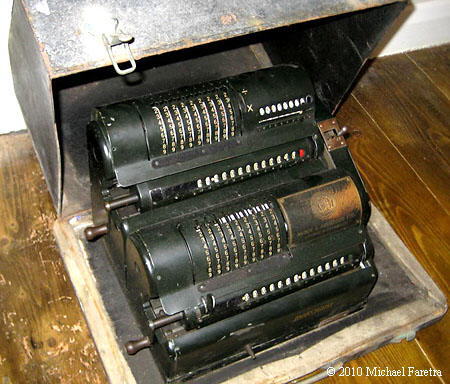
A Twin Marchant in its protective case.
Adrian Furniss, a Technical Author, started the ball rolling when he got in touch with the following information about the Twin Marchant:
"I have it on good authority (my next door neighbour Tony Metcalfe was a Royal Artillery
Surveyor) that the Twin Bank Marchant was a specially procured unit for the British Army comprising two linked, co-mounted, hand-cranked Marchant 'coffee-grinders' used for calculating geographic Eastings and Northings respectively
(left bank Eastings, right bank Northings).
The two banks were linked such that the single handle would operate via a "gearbox" such that turning the handle would perform + +, + -, - - or - + (representing the four quadrants of the compass).
Operationally, these Twin machines were used in a 'Computing Centre' (in the back of a vehicle, a tent or in the open), comprising two 'Compilers' and two 'Computers' (men not machines), all under a Bombardier (a Royal Artillery Corporal). The two 'Computers' would each use a Twin banked machine to perform calculations 'in duplicate', such that the results could be compared. Any discrepancy in Eastings or Northings would trigger a recalculation until identical results were obtained. Accuracy was paramount because the operational role of these machines had a direct effect on the impact point of ordnance! Get it wrong and you could unintentionally shell your own troops, a road, village or town.
The Twin Marchant was introduced by the War Department after the British Expeditionary Force's withdrawal from Dunkirk in 1940, when all their German-made Brunsviga twin bank calculating machines were lost. The Twin Marchant continued with the British Army through to the early 1960s when the smaller, lighter Brunsvigas were reintroduced.
This information has been verified at a reunion of the former soldiers of a survey troop, who used these machines during their service."
Subsequently Tony unearthed the photograph below of Twin Marchants in action.
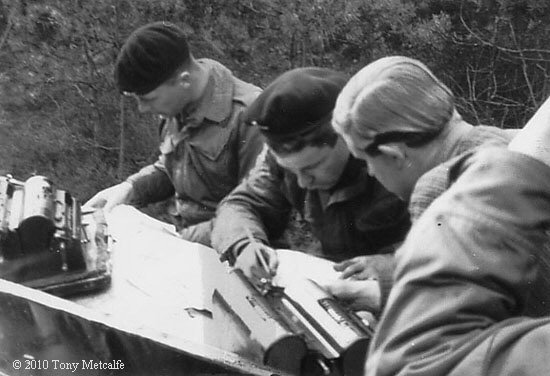
February 1962: Two Twin Marchants in use at a Royal Artillery 'Computing Centre', with Tony Metcalfe on the left. This must be very shortly before the reintroduction of Brunsviga calculators.
This information is confirmed by a review in the journal 'Nature' in 1942[1] of the book "The Twin Marchant Calculating Machine and
its Application to Survey Problems", as can be seen in this extract:
"It would be difficult to exaggerate the importance at the present time of easy and rapid methods of solving the day-to-day
mathematical problems that arise in military survey work. A large number of such methods, many developed by Dr. Comrie himself, depended in the past of the use of the German Brunsviga Twin 13z calculating machine. The
fact that this machine is now, naturally, unobtainable might well have seriously handicapped our fighting forces. It is therefore extremely gratifying to learn that a substitute has been provided by the device of building
together in pairs the well-known American Marchant machines. As Dr. Comrie remarks, this improvisation does not produce the ideal twin machine, but at least it gives us a serviceable and urgently needed war
weapon.
Dr. Comrie's booklet describes this Twin Marchant and deals in detail with its application to about a dozen of the fundamental problems of survey work."
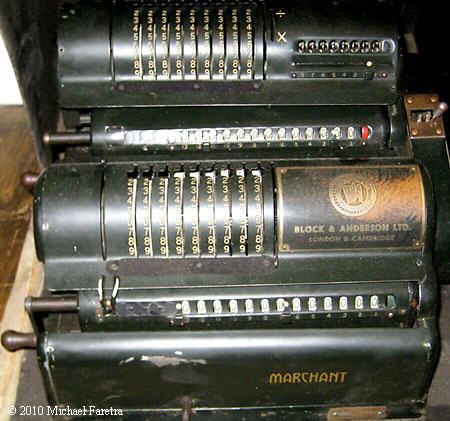
Close up of a Twin Marchant.
Subsequently Adrian Furniss discovered the following article "The Application of Commercial Calculating Machines to Scientific Computing"[2], also by Dr.
Comrie, which expands on the information:
"During the war, when Brunsvigas could not be obtained, an attempt was made to twin the one and only British-made machine of this type - the Britannic, a copy of
the Brunsviga produced 30 years ago during the first world war. The machine itself proved too unreliable for military conditions, so the problem was solved by twinning (in England) lease-lend hand Marchants, which proved
entirely satisfactory. Thus it has come about that there are hundreds of twin Marchants in England, but none in U.S.A., where the single machines were born!"
The photographs of the Twin Marchant here have a plate attached proclaiming "BLOCK & ANDERSON LTD., LONDON & CAMBRIDGE", which would be the company that supplied the machine. Block and Anderson marketed various calculators and were the British distributors for Marchant machines. The actual engineering of the twinning may have been subcontracted out.
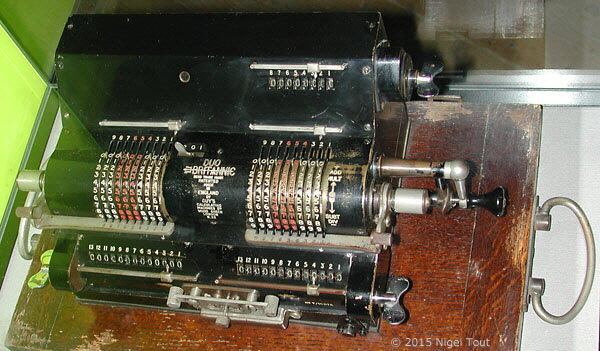
A Britannic Duo, dual pinwheel calculator.
There is more information on Britannic calculators on the Guy's Calculating Machines page.
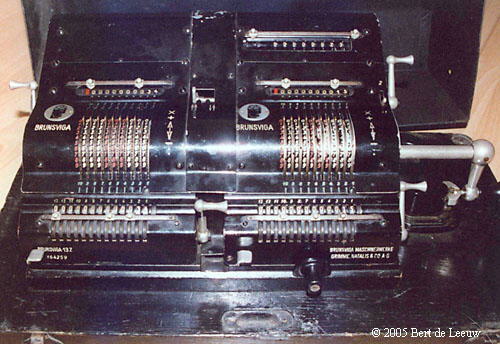
The twin Brunsviga 13Z, for which the Twin Marchant was a substitute.
Twin Marchant Operating Manual
"Directions for the use of Artillery Instruments - Pamphlet No. 11 - The Twin Marchant Calculating Machine - 1944" - This pdf scan of this extremely interesting document was kindly provided by Ite Weide.
(Information allowing republishing of "Crown Copyright" material over 50 years old can be found at https://lists.wikimedia.org/pipermail/wikipedia-l/2005-May/022055.html).
See also the page on Marchant in the Calculator Manufacturers section.
The restoration of a Twin Marchant is detailed at http://www.crisvandevel.de/tpxl.htm with many photographs showing the complexity of these machines.
References:
- Review of "The Twin Marchant Calculating Machine and its Application to Survey Problems", by Dr. L. J. Comrie", Nature 149, 425 (1942), http://www.nature.com/nature/journal/v149/n3781/abs/149425b0.html.
- Leslie John Comrie, "The Application of Commercial Calculating Machines to Scientific Computing", Mathematical Tables and Other Aids to Computation, 2, 1946b, 149.
Calculator Articles
Vintage Calculators
Text & photographs copyright, except where stated otherwise, © Nigel Tout 2000-2025.